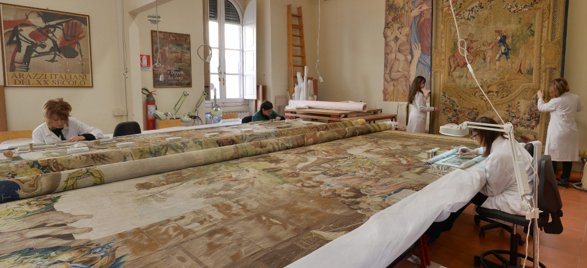Contenuto testuale
The Collections
The Tapestries
The Quirinale Palace’s collection of tapestries currently includes 261 pieces documenting the activity of Europe’s major manufactories and production centres between the 16th and 19th Centuries.
The original collection, which comprised 238 pieces up to a short time ago, has recently been enriched with 23 tapestries of the Neapolitan series of the Stories of Don Quixote deposited at the Superintendence of Artistic and Historical Heritage of Naples, thus turning the Quirinale Palace’s 102-piece Don Quixote series into the best documented in existence.
The collection is among the world’s most outstanding, and not only in numerical terms. Its importance lies in the high quality of all the pieces as they came from the collections of Italy’s pre-Unification States.
Most of the tapestries were taken to the Quirinale Palace during the 1880s, when the Palace was being transformed into a lavish royal palace and required furnishings and works of art that were taken from the royal palaces of the ruling monarchies before Italy was united under the Savoy dynasty.
Many of the tapestries had been installed in Florence during the brief period that it was designated the capital of Italy (1865-1870) and were later brought to Rome.
Among these were the 36 tapestries from the collection of the Duchy of Parma that include, among others, two tapestries by Pergolati with mythological scenes (Brussels 1559-1560); the eight Stories of Scipio the African (Brussels 1650-1665 ca.); the eleven Portières of the Gods (Paris, 1743-1747) woven in the Gobelins Factory; the four Stories of Psyche (Beauvais, 1748-1750 ca.) and the four Love of the Gods (Beauvais, 1750-1752), the latter two series being woven on cartoons by François Boucher.
From the Grand Duchy of Tuscany came the tapestries made in the Manufactory founded by Cosimo I de’ Medici that wove masterpieces like the famous ten-piece series of the Stories of Joseph the Jew (Florence 1545-1553), which were brought to the Quirinale Palace in 1886 while the remaining ten pieces were left in Florence’s Palazzo Vecchio. The valuable series, woven by Flemish artists Rost and Karcher from cartoons by Bronzino and his assistants, gave its name to the Quirinale Palace hall that hosts them called “Bronzino’s Room”.
The House of Savoy collections, especially those from the royal palace of Turin, contributed a large number of tapestries that were linked to the monarchs either by tradition or by custom. They included series commissioned by Charles Emmanuel II, Duke of Savoy, such as the one comprising the four tapestries of the Triumph of the Eucharist and Virtues series (Brussels, 1665); the five Stories of Mark Antony and Cleopatra (Brussels, 1665); the seven Virtues (Brussels, 1665); the six Stories of Ulysses (Brussels, 1665-1666) and the seven Stories of Charlemagne (Brussels, 1665-1666); or tapestries woven in Turin’s Savoy Manufactory for Charles Emmanuel III.
The latter include two Stories of Charlemagne (Turin, 1734-1743), four Stories of Cyrus (Turin, 1750-1756 ca.) and seven Boscarecce rural landscape trompe l'oeuil (Turin, 1753-1775 ca.) from the cartoons of Vittorio Amedeo Cignaroli and his assistants.
From the Duchy of Modena and probably from the city’s Ducal Palace, came the six wall hangings of the New Indies series (Paris, 1771-1786) woven in the Gobelins Manufacture, which were given by Louis XVI to Ferdinand III, Grand Duke of Tuscany, during a visit to Paris.
From the Kingdom of the Two Sicilies came the series of Stories of Don Quixote (Naples, 1757-1779), woven in the Royal Factories of Naples, together with the seven-piece series of Stories of Don Quixote (Paris, 1721/22-1735) woven in the Gobelins Manufactory that were used as a prototype for the Neapolitan series.
Some of the tapestries were left in the Quirinale Palace by Pius IX when he had to abandon the residence after the troops of the House of Savoy entered Rome (20 September 1870).
Strangely, in the Vatican’s later requests to return the furnishings left in the Quirinale Palace, which were readily met by the Italian government, no mention was made of the five tapestries, which therefore came to form part of the Kingdom of Italy and now bear a rare testimony of the Palace’s previous furnishing during the reign of the popes.
These include four tapestries of the New Testament (Paris, 1753-1764) woven by the Gobelins Manufactory and given by Napoleon to Pius VII in 1805, and The Last Sermon of Saint Stephen (Paris, 1819-1824), which Leo XII donated to the Apostolic Palace and now hangs on the altar of the Pauline Chapel.
In 1872, concomitantly with the purchase of the Castelporziano castle and estate by Duke Pio Grazioli, the Crown purchased four tapestries, three of which were the magnificent French-made Stories of Psyche (Aubusson ?, 1750 ca.) woven in the middle of the 1700s from 16th Century models.
The Presidential collection of tapestries, born from the practical need to quickly endow Italy’s new Royal Palace with furnishings of adequate quality, is unique in terms of the quantity and variety of tapestries documenting the work of flourishing Italian and European manufactories and at the same time effectively vouching for the lofty cultural traditions that the pre-Unification States contributed to the creation of a unified Italy.
The Tapestry Maintenance and Restoration Operating Centre
In 1995 the Quirinale Palace opened the Tapestry Maintenance and Restoration Operating Centre which, in conjunction with the Ministry for Cultural Heritage and Activities, established and coordinates two laboratories with highly qualified in-house personnel that have successfully restored a consistent number of tapestries (120 by 2015).
In addition to the laboratories, a special storage room was created for the conservation of the tapestries awaiting restoration, which follows a given schedule.

